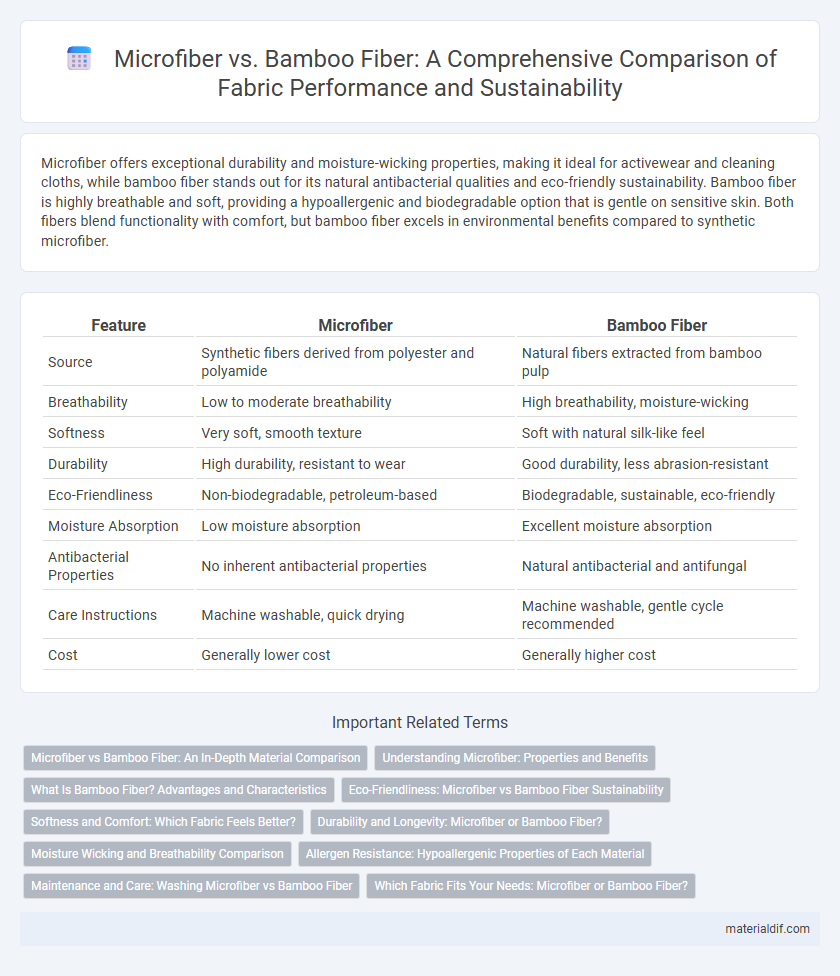Microfiber offers exceptional durability and moisture-wicking properties, making it ideal for activewear and cleaning cloths, while bamboo fiber stands out for its natural antibacterial qualities and eco-friendly sustainability. Bamboo fiber is highly breathable and soft, providing a hypoallergenic and biodegradable option that is gentle on sensitive skin. Both fibers blend functionality with comfort, but bamboo fiber excels in environmental benefits compared to synthetic microfiber.
Table of Comparison
| Feature | Microfiber | Bamboo Fiber |
|---|---|---|
| Source | Synthetic fibers derived from polyester and polyamide | Natural fibers extracted from bamboo pulp |
| Breathability | Low to moderate breathability | High breathability, moisture-wicking |
| Softness | Very soft, smooth texture | Soft with natural silk-like feel |
| Durability | High durability, resistant to wear | Good durability, less abrasion-resistant |
| Eco-Friendliness | Non-biodegradable, petroleum-based | Biodegradable, sustainable, eco-friendly |
| Moisture Absorption | Low moisture absorption | Excellent moisture absorption |
| Antibacterial Properties | No inherent antibacterial properties | Natural antibacterial and antifungal |
| Care Instructions | Machine washable, quick drying | Machine washable, gentle cycle recommended |
| Cost | Generally lower cost | Generally higher cost |
Microfiber vs Bamboo Fiber: An In-Depth Material Comparison
Microfiber, made from ultra-fine synthetic fibers like polyester and nylon, offers superior moisture-wicking, durability, and stain resistance compared to natural bamboo fiber, which excels in breathability and eco-friendliness due to its renewable source and biodegradability. Bamboo fiber provides natural antibacterial properties and softness but tends to absorb more moisture and lacks the quick-drying advantages of microfiber. When choosing between microfiber and bamboo fiber, considerations include microfiber's high strength and technical performance versus bamboo's sustainability and comfort benefits.
Understanding Microfiber: Properties and Benefits
Microfiber is a synthetic fiber made from ultrafine polyester and polyamide threads, known for its exceptional softness, durability, and moisture-wicking properties. It offers superior breathability, quick-drying capabilities, and resistance to stains and wrinkles, making it ideal for activewear and upholstery. Microfiber's tightly woven structure enhances its ability to trap dust and allergens, promoting hygienic and low-maintenance fabric solutions.
What Is Bamboo Fiber? Advantages and Characteristics
Bamboo fiber is a natural textile made from the pulp of bamboo grass, known for its eco-friendly and sustainable properties. It features remarkable breathability, moisture-wicking ability, and natural antibacterial qualities, making it ideal for sensitive skin and activewear. Bamboo fiber also stands out for its softness, durability, and biodegradability compared to synthetic fabrics like microfiber.
Eco-Friendliness: Microfiber vs Bamboo Fiber Sustainability
Bamboo fiber is widely recognized for its eco-friendliness due to its rapid renewability, natural biodegradability, and minimal pesticide use during cultivation, making it a sustainable textile choice. Microfiber, typically made from synthetic polymers like polyester or nylon, poses environmental challenges due to its reliance on fossil fuels and the release of microplastics during washing, which contribute to ocean pollution. Choosing bamboo fiber over microfiber significantly reduces ecological impact and supports sustainable fabric production practices.
Softness and Comfort: Which Fabric Feels Better?
Microfiber fabric offers exceptional softness with a smooth, silky texture that feels gentle against the skin, making it ideal for comfortable bedding and clothing. Bamboo fiber is naturally breathable and moisture-wicking, providing a cool, soft touch that enhances comfort, especially in warm climates. While microfiber excels in consistent plushness, bamboo fiber stands out for its eco-friendly softness and superior breathability, appealing to those seeking natural comfort.
Durability and Longevity: Microfiber or Bamboo Fiber?
Microfiber exhibits exceptional durability due to its synthetic polyester and polyamide composition, resisting wear and tear over extended use. Bamboo fiber, while naturally antibacterial and eco-friendly, tends to degrade faster with repeated washing, reducing its longevity compared to microfiber. For applications demanding long-lasting fabric performance, microfiber typically offers superior durability and lifespan.
Moisture Wicking and Breathability Comparison
Microfiber fabric excels in moisture-wicking by quickly drawing sweat away from the skin, making it ideal for activewear and high-intensity workouts. Bamboo fiber offers superior breathability due to its natural porous structure, allowing better air circulation and enhanced comfort in hot climates. While microfiber prioritizes fast-drying performance, bamboo fiber provides a more breathable, eco-friendly option with natural antibacterial properties.
Allergen Resistance: Hypoallergenic Properties of Each Material
Microfiber is made from tightly woven synthetic fibers, creating a dense fabric that resists dust mites and allergens, making it highly hypoallergenic and ideal for sensitive skin. Bamboo fiber, derived from natural bamboo pulp, possesses inherent antimicrobial and moisture-wicking properties that reduce allergen buildup and inhibit bacterial growth. Both fabrics offer excellent allergen resistance, but bamboo's natural hypoallergenic qualities and breathability provide additional comfort for allergy sufferers.
Maintenance and Care: Washing Microfiber vs Bamboo Fiber
Microfiber fabric requires low-temperature washing, typically below 104degF (40degC), with mild detergents to preserve its water-resistant and quick-drying properties. Bamboo fiber demands gentle care with cold water washing and avoiding bleach or fabric softeners to maintain its natural antibacterial qualities and softness. Both fabrics benefit from air drying, but microfiber can handle low-heat tumble drying, whereas bamboo fiber is best kept away from heat sources to prevent shrinkage and fiber damage.
Which Fabric Fits Your Needs: Microfiber or Bamboo Fiber?
Microfiber, made from finely woven synthetic fibers, excels in durability, moisture-wicking, and stain resistance, making it ideal for activewear and cleaning materials. Bamboo fiber, derived from bamboo pulp, offers exceptional softness, natural antibacterial properties, and eco-friendliness, perfect for sensitive skin and sustainable fashion choices. Selecting between microfiber and bamboo fiber depends on whether you prioritize performance and easy care or comfort and environmental sustainability.
Microfiber vs Bamboo Fiber Infographic

 materialdif.com
materialdif.com